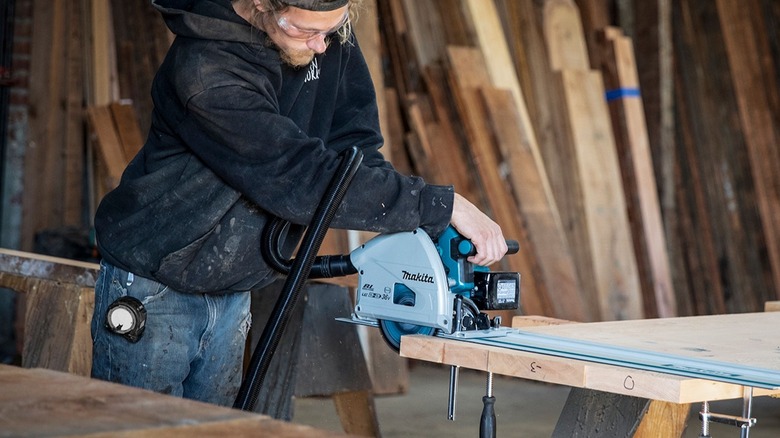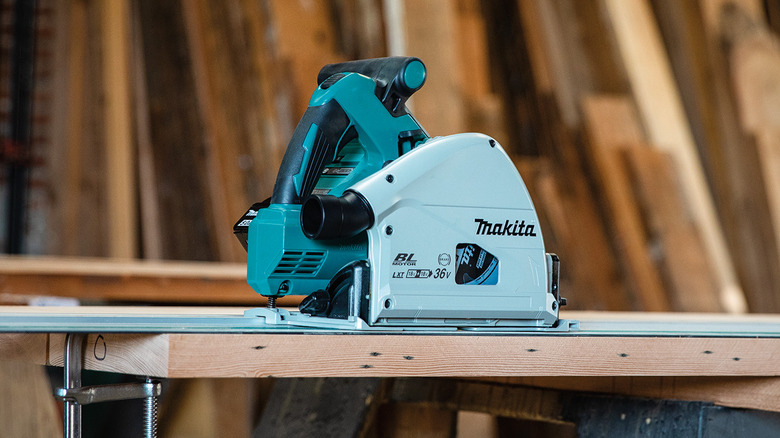Corded Vs. Cordless Makita Track Saw: What Are The Pros & Cons Of Both?
The track saw is a wonderful tool. There are few better ways to make incredibly precise cuts to pieces of wood, as the guide rail lets you maintain straight lines across significant distances. Nobody wants to eyeball a straight line that is a foot and a half long. The tool company Makita has a number of different track saws — also known as plunge saws — available for purchase. If you're planning to buy one, you need to make a big decision: whether to get a corded or cordless model. Both of these models have their strong and weak points, and it is simply a matter of which pros and cons affect you most that determines which Makita track saw model would be best for you.
Let's begin with how the corded and cordless Makita track saws bear a striking resemblance to one another. For both models, the most common blade size you will find is one with a 6.5-inch diameter. In both cases, they are able to handle fairly large cutting capacities. When at 90 degrees, each can handle a 2-3/16 inch cut, and at 45 degrees, that maximum cut capacity is 1-9/16 inches. In terms of how you make the cuts, the two saws work in much the same way. That is actually where the similarities between the Makita corded and cordless track saws end. Once you get into all the details, you can really see how the two track saw experiences differ and get a sense of where one performs better than the other, depending on the scenario.
The pros and cons of the corded Makita track saw
The most obvious benefit of a corded Makita track saw is that it does not need to be charged to be used. Once you plug your saw into an outlet, you are good to go and are able to make cuts for as long as you wish. Makita's saw does have a built-in current limiter too, so you don't need to worry about burning out the track saw's 12 Amp motor. It also has a soft start feature that gently powers the saw up to its higher power outputs to further avoid overworking your track saw too quickly. Another pro is that the corded track saw comes with a 55-inch guide rail included. For cordless models, guide rails are sold separately.
Having a power cord provides steady power, but it does limit where you can perform your work. You need to have access to a power outlet, and if you are really far from one, you need to get yourself an extension cord. Beyond that obvious con, there are other limitations as well. Makita only produces one corded plunge saw compatible with a guide rail, so if you were hoping for something that has a larger blade, you're out of luck. You would need to go cordless for that. The corded saw's maximum speed is also much slower than a cordless model, maxing out at 5,200 rpm, while a cordless model can get up to 6,300 rpm. It may not be the most powerful option, but you can bank on old-school reliability.
The pros and cons of the cordless Makita track saw
Accessibility is a major pro of Makita track saws. Being untethered, you have the ability to set up a workstation anywhere you please. Along with that accessibility comes variety as well. While Makita does offer a cordless model with a 6.5-inch plunge saw that operates exactly the same way as the corded model — though with an increased rotational limit of 6,300 rpm — there are other blade sizes available for purchase that do not even adhere to the same plunge saw design. Because Makita makes you purchase a guide rail separately, you can transform a good number of Makita's circular saws into track saws. That variety also extends to Makita's battery systems, as there are models available for both the LXT and XGT battery systems.
The biggest drawback of getting a cordless model is the price. Not only do you have to buy the saw, you also have to purchase two batteries because it requires two at once to operate, chargers for those batteries, and a guide rail that you have to attach. The Home Depot sells a corded model with a 55-inch guide rail for $589, and you can get a kit for the equivalent cordless model for $699. That kit does include batteries and chargers, but it doesn't include a guide rail, which is an additional $93.99 for a 55-inch model. Another con is that you are at the mercy of your battery life, which can vary depending on your power output and which cordless saw model you're operating. It's up to you if that accessibility and variety are enough to offset those challenges.


